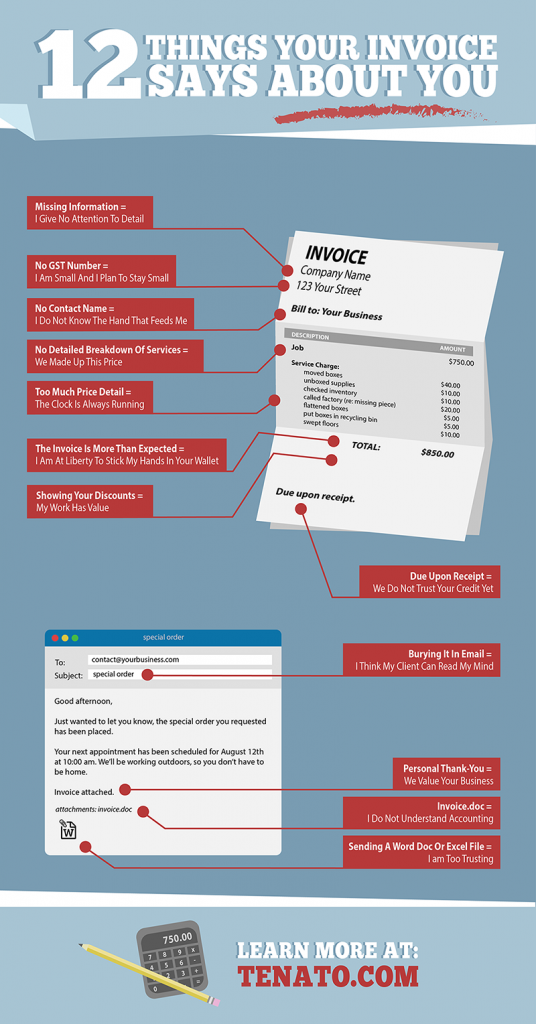What Your Invoice Says About You
I was catching up my books for year-end recently, filing through all sorts of invoices I’d received over past months. Many of the invoices made me chuckle. It seems that many small business owners have no clue how to make a respectable invoice. And the problem is, if your invoice isn’t respectable, it can be taken less seriously when it comes to getting paid on time, or whether or not you get hired again. After all, you may think the invoice just goes to the accounting department in a company, but in reality the  decision maker who hired you has to sign-off on whether or not it should be paid (and sometime how fast it is paid) before forwarding it to their accountant/bookkeepers, so the client is, without a doubt, going to take a good hard look at it!
decision maker who hired you has to sign-off on whether or not it should be paid (and sometime how fast it is paid) before forwarding it to their accountant/bookkeepers, so the client is, without a doubt, going to take a good hard look at it!
With that in mind, let’s consider your invoice as a little piece of marketing. Now, what is it saying about you?
Due Upon Receipt = “We Do Not Trust Your Credit Yet.”
For some reason, some vendors with whom we’ve worked for years still have a “DUE UPON RECEIPT” on their invoices. Is there any reason not to put a due date on it? Give a reasonable amount of time (10 – 30 days) to people you trust or with whom you have worked for a long time, and proven their credit. It’s a common courtesy. I also had a vendor back-date an invoice (which may have been just an error) but it looked like he did it to make me rush payment, thinking it was late. Yes, the date on your invoice can really create or erode trust.
No GST Number = “I Am Small And I Plan To Stay Small.”
Business owners know that if you generate more than $30,000 in revenue, you have to have a GST number. If you don’t have one, that obviously means you’re generating UNDER 30K per year, which is very small. Not only that, it means you aren’t expecting to crack the 30K mark. What if your client wanted to give you a job bigger than $30K? Well, it kind of says you’re not set up to handle it, nor would you really want it.
Sending A Word Doc Or Excel File = “I Am Too Trusting.”
I appreciate that you trust us, but sending an editable file is very risky. The client can easily change the amount or math on the invoice, to harm you or fake things in their books. When you create an invoice, you should save it as a .pdf file, which is harder (though not impossible) to edit. It at least says this is a finished document, not to be edited by the client.
Missing Information = “I Give No Attention To Detail.”
I’ve gotten invoices that said “CompanyName” where it should have actually had a real company name, and “123 YourStreet “ where it should have had an address, and had the wrong year in the date field. Is this the first time you’re used a Word processor? Look in all the fields, and make sure everything is filled in correctly. Create a logo for your name if you can, and make it as professional as possible to be taken seriously.
No Detailed Breakdown Of Services = “We Made Up This Price.”
An invoice, unless it’s for something very simple, should be broken down into 3 to 5 pieces, just to make sense of the price. If you have no breakdown of the price, it comes across as unjustified. It’s as though you just decided that’s what you wanted to charge, with no rationale. Put clear descriptions (not just part numbers or codes) on your invoice so the client can remember what they bought and know how to code it into their accounting system easily.
Too Much Price Detail = “The Clock Is Always Running.”
If you break down everything into 25 cent intervals, the client will feel he/she is being “nickel and dimed” for everything. It’s more likely to raise their ire, and a long invoice with many tiny pieces can generate a lot of scrutiny, and make the client feel like NOTHING you do is free…every phone call or email or screw or bolt means they’ll get billed. This can really erode goodwill and trust.
“Invoice.doc” = “I Do Not Understand Accounting.”
Think about it. If all of a company’s vendors named every invoice as “invoice.doc,” how can the company easily tell which invoice is from which company? I so appreciate it when a vendor consistently names their invoice files, including their name and an invoice number in it for easy reference. One of my vendors also includes the name of the job in the file name…(kudos, True Media)! The invoice numbers are also consistent (not just made off of the date) which makes them much easier to enter and search in an accounting program.
No Contact Name = “I Do Not Know The Hand That Feeds Me.”
There is always going to be one person within a company who has to sign off on that invoice of yours. THAT person’s name must be on the invoice, “ATTN: Barbara Doll.” And don’t insult them by misspelling it.
Burying It In Email = “I Think My Client Can Read My Mind.”
You CAN send invoices by email, and most companies do. The problem occurs in attaching it with a message that is about all sorts of other things, and not including the word “INVOICE” in the subject line. Sometimes I’ll realize, “Hey, this vendor hasn’t invoiced me in awhile…” and I go searching for invoices in my inbox. If they don’t have the word “INVOICE” in the subject line, it’s likely I’m going to miss it, especially if it’s attached at the bottom of an email. If you want to actually get PAID reasonably on time, put “INVOICE” in your subject line while you’re sending it to the right contact person.
Showing Your Discounts = “My Work Has Value.”
A lot of companies throw in extra value and freebies along the way. By showing this on the invoice, it becomes visible and tangible to the client, and increases your ability to negotiate in the future. It’s a great way to be ready for the, “What have you done for me lately?” moments, or prevent them altogether. It can also get a “Thank-you for giving me a break on this!” instead of a “Well, the discounted price was the actual price.” assumption.
The invoice Is More Than Expected = “I Am At Liberty To Stick My Hands In Your Wallet.”
This is essentially why we often recommend against un-budgeted hourly rates (or even the expenses that go with them). The assumption becomes “You will have to pay whatever I decide.” If you are charging hourly rates, I strongly recommend you give people a clear idea of what you expect the invoice will be before you bill, and you bill often to keep the invoices current and manageable. Big bills can always be broken into smaller ones. This will prevent the client from getting what I call toxic bill-shock…a common affliction that will kill a client relationship.
Personal Thank-You = “We Value Your Business.”
Did you just send an email that says nothing but “Invoice attached”? and had no bit of friendliness with it? It doesn’t take much to make a client feel like you’re only in it for the money, because after all, it’s a business relationship. So remember, you can put it on the invoice itself, or in the cover letter of your email, but either way, say something nice about the project or work you did, and how you’re grateful to have had the opportunity to work with them, and how keen you are work with them again. Also, be sure to tell them to call you if they have any questions about the invoice – that’s always a good opportunity to head off problems before they delay payment.
Next time you’re preparing an invoice, remember, it’s a key piece of marketing that can build trust or erode it. Make it the best possible reflection on your business that it can be, and you’ll get more business, and get paid more quickly.
We would love to have your comments on your experience with invoicing. Drop us a comment here and you’ll always get a personal reply.



Yep, you were right. Loved it! Very clever. We are going to need to sharpen our pencils to make invoicing as interesting as you did right here!
Thanks Zipbooks! So glad you liked it – Great to meet you via Twitter!